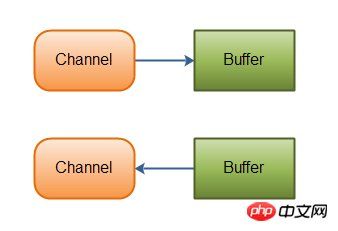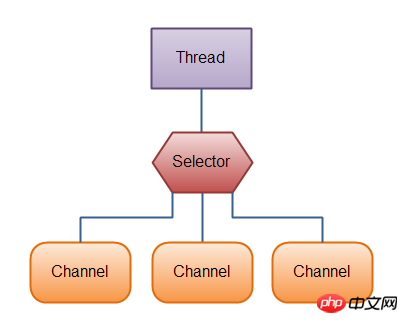Java NIO series tutorial 1: A brief introduction to Java NIO
Java NIO consists of the following core parts:
Channels
Buffers
Selectors
Although there are many classes and components in Java NIO, in my opinion, Channel, Buffer and Selector constitute The core API. Other components, such as Pipe and FileLock, are just utility classes used with the three core components. Therefore, in this overview I will focus on these three components. Other components are covered in separate chapters.
Channel and Buffer
Basically, all IO starts from a Channel in NIO. Channels are a bit like streams. Data can be read from the Channel to the Buffer, or written from the Buffer to the Channel. Here is an illustration:


#There are several types of Channel and Buffer. The following are the implementations of some major Channels in JAVA NIO:
FileChannel
DatagramChannel
SocketChannel
ServerSocketChannel
As you can see, these channels cover UDP and TCP network IO, as well as file IO.
Along with these classes there are some interesting interfaces, but for the sake of simplicity I tried not to mention them in the overview. I will explain them in other chapters of this tutorial where they are relevant.
The following is the key Buffer implementation in Java NIO:
ByteBuffer
CharBuffer
DoubleBuffer
FloatBuffer
IntBuffer
LongBuffer
ShortBuffer
These Buffers cover the basic data types you can send through IO: byte, short, int, long, float, double and char.
Java NIO also has a MappedByteBuffer, which is used to represent memory mapped files. I am not going to explain it in the overview.
Selector
Selector allows a single thread to process multiple Channels. If your application opens multiple connections (channels), but the traffic of each connection is very low, using Selector can be convenient. For example, in a chat server.
This is an illustration of using a Selector to process 3 Channels in a single thread:


To use the Selector, you must register with the Selector Channel, and then calls its select() method. This method will block until a registered channel has an event ready. Once this method returns, the thread can handle these events. Examples of events include new connections coming in, data receiving, etc.
Related articles:
Java NIO series tutorial 2: Java NIO channel-like stream
Java NIO Series Tutorial 3: Basic Usage of Buffer
Related Videos:
Illustration of JDK Download Process-JAVA Elementary Introduction Video Tutorial
The above is the detailed content of Java NIO series tutorial 1: A brief introduction to Java NIO. For more information, please follow other related articles on the PHP Chinese website!

Hot AI Tools

Undresser.AI Undress
AI-powered app for creating realistic nude photos

AI Clothes Remover
Online AI tool for removing clothes from photos.

Undress AI Tool
Undress images for free

Clothoff.io
AI clothes remover

Video Face Swap
Swap faces in any video effortlessly with our completely free AI face swap tool!

Hot Article

Hot Tools

Notepad++7.3.1
Easy-to-use and free code editor

SublimeText3 Chinese version
Chinese version, very easy to use

Zend Studio 13.0.1
Powerful PHP integrated development environment

Dreamweaver CS6
Visual web development tools

SublimeText3 Mac version
God-level code editing software (SublimeText3)

Hot Topics
 1393
1393
 52
52
 1207
1207
 24
24
 Is the company's security software causing the application to fail to run? How to troubleshoot and solve it?
Apr 19, 2025 pm 04:51 PM
Is the company's security software causing the application to fail to run? How to troubleshoot and solve it?
Apr 19, 2025 pm 04:51 PM
Troubleshooting and solutions to the company's security software that causes some applications to not function properly. Many companies will deploy security software in order to ensure internal network security. ...
 How to simplify field mapping issues in system docking using MapStruct?
Apr 19, 2025 pm 06:21 PM
How to simplify field mapping issues in system docking using MapStruct?
Apr 19, 2025 pm 06:21 PM
Field mapping processing in system docking often encounters a difficult problem when performing system docking: how to effectively map the interface fields of system A...
 How to elegantly obtain entity class variable names to build database query conditions?
Apr 19, 2025 pm 11:42 PM
How to elegantly obtain entity class variable names to build database query conditions?
Apr 19, 2025 pm 11:42 PM
When using MyBatis-Plus or other ORM frameworks for database operations, it is often necessary to construct query conditions based on the attribute name of the entity class. If you manually every time...
 How does IntelliJ IDEA identify the port number of a Spring Boot project without outputting a log?
Apr 19, 2025 pm 11:45 PM
How does IntelliJ IDEA identify the port number of a Spring Boot project without outputting a log?
Apr 19, 2025 pm 11:45 PM
Start Spring using IntelliJIDEAUltimate version...
 How do I convert names to numbers to implement sorting and maintain consistency in groups?
Apr 19, 2025 pm 11:30 PM
How do I convert names to numbers to implement sorting and maintain consistency in groups?
Apr 19, 2025 pm 11:30 PM
Solutions to convert names to numbers to implement sorting In many application scenarios, users may need to sort in groups, especially in one...
 How to safely convert Java objects to arrays?
Apr 19, 2025 pm 11:33 PM
How to safely convert Java objects to arrays?
Apr 19, 2025 pm 11:33 PM
Conversion of Java Objects and Arrays: In-depth discussion of the risks and correct methods of cast type conversion Many Java beginners will encounter the conversion of an object into an array...
 Why does the Spring project cause randomness problems due to circular dependencies when starting?
Apr 19, 2025 pm 11:21 PM
Why does the Spring project cause randomness problems due to circular dependencies when starting?
Apr 19, 2025 pm 11:21 PM
Understand the randomness of circular dependencies in Spring project startup. When developing Spring project, you may encounter randomness caused by circular dependencies at project startup...
 How to use the Redis cache solution to efficiently realize the requirements of product ranking list?
Apr 19, 2025 pm 11:36 PM
How to use the Redis cache solution to efficiently realize the requirements of product ranking list?
Apr 19, 2025 pm 11:36 PM
How does the Redis caching solution realize the requirements of product ranking list? During the development process, we often need to deal with the requirements of rankings, such as displaying a...




